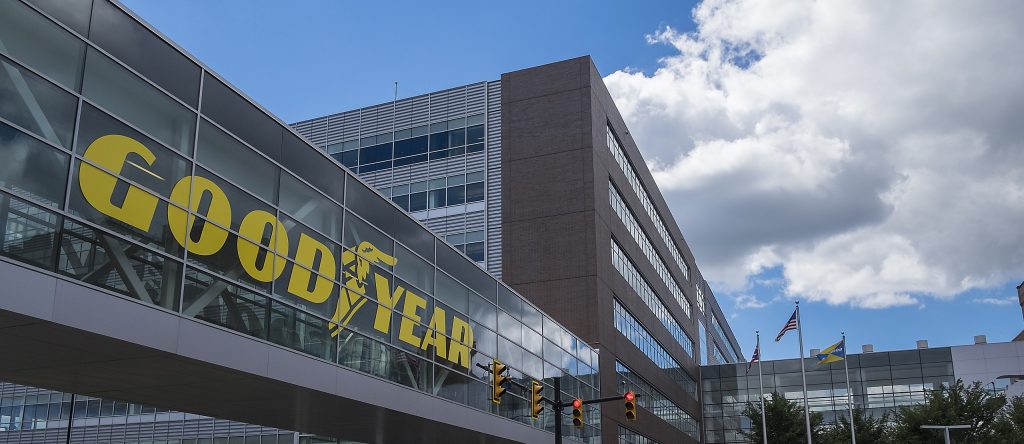These days tires are made through an almost fully automated process of mixing ingredients, heating and shaping/moulding the tires. The tire building machine can be fully automated or it can be manually controlled. Quite a few types of ingredients are needed to make a fully finished tire. All these ingredients play a vital role in the tire manufacturing process to create all the different components needed.
Tires are made in 2 phases; the inner liner, fabric ply, steel beads and sidewalls are assembled as the carcass of the tire. The belts, cap plies and tread are the belt assembly.
The main ingredients in manufacturing tires are as you guessed rubber. Materials like steel and fiber are also used to strengthen the tire. Different kinds of chemicals are used to prepare the rubber for their different roles, for example the tread and the sidewall have a different rubber formula.
What are tires made of?
Rubber; natural rubber (polyisoprene) comes from the rubber tree (Hevea brasiliensis) and is harvested in the form of latex.
Latex is in most cases a white milky fluid extracted from the bark of the tree. This milky fluid acts as a defence against plant eating insects. The raw natural rubber is in a white form to begin with before processing to become a tire.
Natural rubber is mainly produced in south east Asia where plantations are grown. This latex when mixed with acids will solidify and will be stored in the form of bales. Mainly 3 kinds of synthetic rubber are used in tire production and each of them have different physical and chemical characteristics.
Butadiene rubber and Styrene butadiene (SBR) can be partly substituted for natural rubber and are used in combination with different rubbers. Butadiene rubber prevents heat build up in the tire. Halobutyl rubber is used mostly with the inner tire for its impermeability properties and to keep air from diffusing through the rubber.
Steel and fabric; steel and nylon/polyester cords are used to reinforce the tire. These steel and nylon/polyester cords are encased with rubber strips to make tires more durable.
Chemicals; sulfur, activators and accelerators are used in the vulcanizing process where the tire is heat treated (baked). Accelerated vulcanization uses a mixture of compounds referred to as the cured package.
The most important activator is zink oxide and assists in the vulcanization process. Antioxidants and antiozonants protect the sidewalls from sunlight and ozone reactions.
Silica and carbon black (fillers); carbon black is formed with the incomplete combustion of coal or petroleum products and is a soft black powder. It is a pigment and is used as a tire colorant as well as a reinforcing filler in tires.
Carbon black is mixed with the rubber to increase the durability of tires. Silica also gets added to the mixture and helps prevent excess heat build up in the tires. Silica is especially used in high performance tires for this reason.
Oil; most of the rubber tires are made of is synthetic rubber and a key ingredient in making tires is crude oil. Oil is being used to make isoprene rubber (IR) and is very similar to natural rubber and colourless of nature. Synthetic rubber has different properties than natural rubber, they are especially more heat resistant.
Now that we covered “What are tires made of?”, we can continue with our journey and on the the manufacturing process.
How are tires made: The tire manufacturing process

Now we are getting to the fun part of how tires are made. We know all the ingredients needed to build a tire, but what do we do with it?
Mixing of ingredients; tires are made with between 10 -15 components including natural and synthetic rubber, chemical additives and carbon black which is a pigment. Large mixers mix these raw materials under extreme heat and pressure so that all components mix thoroughly. The mixing is a batch operation and the machine has rotors inside that break down the raw rubber and thoroughly mix it with the other ingredients into a homogeneous substance. Temperature control is very important and mixing happens in 2 stages with different temperatures. Stage one mixing is at much higher temperatures, but too high temperature may scorch the ingredients. The curative package is added in the second stage where the temperature is lower. Different parts of the tire need different formulations to shape a rubber for a certain purpose, for example the inner tire, tread or sidewall have different properties.. The newly mixed rubber then goes through rolling mills that squeeze the batch into a thick rubber sheet. No matter what formula is used, the result is always a continuous sticky rubber sheet and gets stacked for later use.
Calender machine; it has multiple rollers where rubber sheets are squeezed through making a rubber sheet with a certain thickness. Here fabric or steel cords are added to strengthen the rubber layers needed for tire manufacture.
Extrusion machine; the rubber compound is fed into the extruder by a screw and is further mixed and heated under pressure in the barrel of the extruder. Then the rubber compound is transferred to a different chamber in the extruder where it is shaped under pressure and pushed through a die. Rubber is made into a specific shape for a specific purpose.
Inner liner; a rubber sheet with rubber compounds that minimize air diffusion through it keeping the tire inflated. A Calendar is used resulting in a wide thin rubber sheet and is cut to a predetermined length.
Fabric ply; two or three strings of yarn are twisted together to make a cord and then treated before it gets shipped to the tire manufacturing plant. The calendar, which is equipped with rollers, is loaded with polyester fabric. Here warm rubber is added to both sides of the fabric producing a rubber fabric combination. From here cotton threads are rolled with machinery that pulls the cord onto the rubberized fabric running parallel to each other and sticks making a fabric ply. The purpose of the fabric ply is to strengthen the tire and make it more durable.
Tread; making the tread needs 3 different kinds of rubber, an extruder shapes the 3 streams of rubber and then they enter a dye which forms them into one. A blade then cut the newly formed tread sheet into the right lengths.
Steel beads; steel wires needed for cords are all brass coated. The beads are made from many steel coils pulled simultaneously into a specified configuration and encased in rubber. The steel beads are the part needed for the tire to stay on the wheel rim. Machines then roll the steel beads into hoops to fit the wheel rim.
Apex (filler); extruded apex are applied onto the steel beads . Triangular shaped and serves as a cushion between the steel bed and soft inner liner This helps with driving stability, better steering and comfort.
Steel belt; this is one of the outer rubber layers of the tire and adds resistance to punctures making the tire more durable.. As with the fabric ply a calender machine is used to reinforce the rubber ply with steel cords.
Sidewalls; an extra thick layer of supportive rubber with additives like antioxidants and antiozonants protecting the tire from environmental factors. Sidewalls are made with an extrusion machine where the rubber is shaped.
How are tires made: Tire building machine
Now you may ask again. How are tires made? Tires are made with a special tire building machine with rotating drums. The tire is built from the inside out.
Inner tire; starting with 2 steel bead hoops arranged on it. Then a air tight piece of rubber is rolled between the hoops and will be the inner tube of the tire, then the corded fabric ply is wrapped around the inner tube. Inflated bladders roll the rubber around the beads on both sides. Sidewalls are then added to the beads, rollers then fold the sidewalls over the beads. This completes the inner tire.
Outer tire; The outer layers are assembled separately, beginning with strips of rubber embedded with steel cord. This rubber steel belt is wrapped around a second building drum. Then narrow strips of rubber ply are added to the steel belt. Lastly the tread rubber is applied to the tire building drum wrapping it over the rubber ply, giving it the last layer of rubber.
Combining inner and outer tire; a Transfer ring fits the outer layer onto the inner layer and it becomes one. Air inflates the tire shaping it and making all the layers of the tire stick together. Then the edge of the tread rubber is rolled over the sidewalls. The end result is called a ‘green tire’, a tire without tread pattern.
Vulcanization (curing process); the ‘green tire’ is then put in a mold to bake and shape. Inside bladders inflate to shape the tire and the tread pattern is transferred onto the green tire. By now all the layers of the tire are fused together resulting in the final product. The time in the hot pressurized mold caused the rubber to vulcanize (hardening), a chemical reaction transforming the soft tire into a strong elastic tire.
Afterwards the excess rubber is trimmed. Last step of tire manufacture is the inspection part to see if the tire shape is uniform and there are no defects.
Inspection
First the tire is tested for uniformity and balance. They are fitted on wheel halves and run on a simulated road surface. X-Ray tests will penetrate the rubber to see the tire structure inside for any defects. The final test is a visual test to see if there are any defects on the tire surface.
There are also continuous inspections throughout the tire manufacturing process to see if everything is at a high standard.
Conclusion

The answer to the question “How tires are made?” is not that straight forward and a lot goes into manufacturing one tire. Big tire companies like Michelin have very high standards when it comes to tire manufacture, to make sure their tires are of the highest quality and that every tire will pass the inspection. They are always looking for ways to add to a tire’s performance and safety and making it more economical for the customers. Where are Michelin tires made? Big tire companies are world wide and produce tires in many countries, catering for that country’s special needs.
The process described is for a normal stock/summer tire. Making special or performance tires will need more steps to get to the final product and some added ingredients for performance enhancing. For example a car stock tire needs to be vulcanized for about 15 minutes where a truck tire needs to stay in the vulcanized mold for about 24 hours.
When buying a new car with its new tires drive carefully, because the new tires still need to be worn in. Gentle driving is needed for at least 500 miles (800 km). This is the time needed for all the tire making material and lubricants that diminishes the grip of the tire to wear off.



